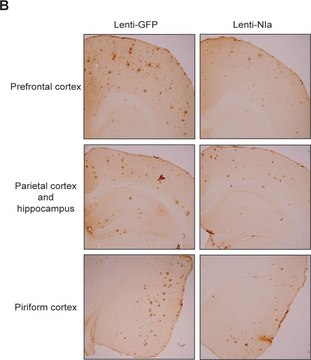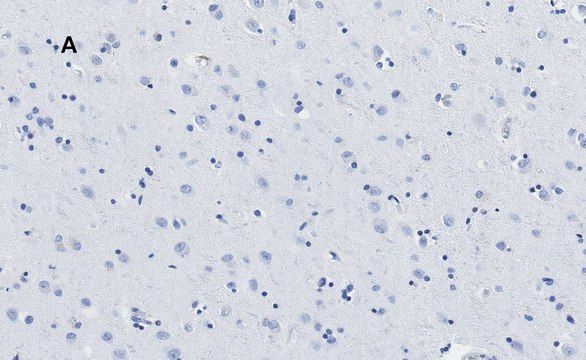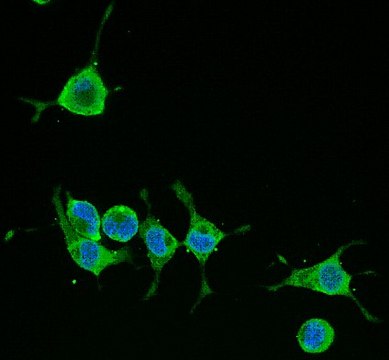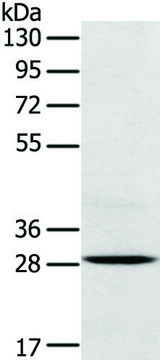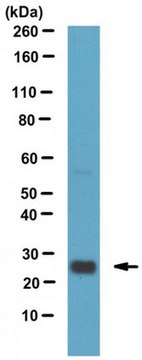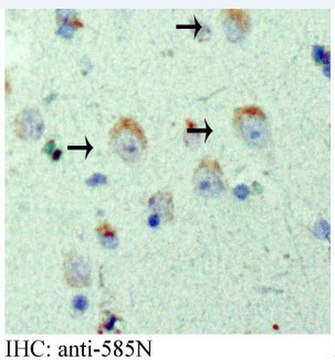ABN1643
Anti-APP Antibody, AEP-cleaved (373N)
serum, from rabbit
别名:
Amyloid beta A4 protein, 373N fragment, ABPP, 373N fragment, Alzheimer disease amyloid protein, 373N fragment, Amyloid precursor protein, 373N fragment, APP, 373N fragment, APPI, 373N fragment, Cerebral vascular amyloid peptide, 373N fragment, CVAP, 373N
登录查看公司和协议定价
所有图片(3)
About This Item
UNSPSC代码:
12352203
eCl@ss:
32160702
推荐产品
生物来源
rabbit
质量水平
抗体形式
serum
抗体产品类型
primary antibodies
克隆
polyclonal
种属反应性
human, mouse
种属反应性(根据同源性预测)
porcine (based on 100% sequence homology), nonhuman primates (based on 100% sequence homology), canine (based on 100% sequence homology), guinea pig (based on 100% sequence homology)
技术
immunohistochemistry: suitable
western blot: suitable
NCBI登记号
UniProt登记号
运输
ambient
靶向翻译后修饰
unmodified
基因信息
human ... APP(351)
一般描述
Amyloid beta A4 protein (UniProt P05067; also known as ABPP, Alzheimer disease amyloid protein, Amyloid precursor protein, APP, APPI, Cerebral vascular amyloid peptide, CVAP, PN-II, PreA4, Protease nexin-II) is encoded by the APP (also known as A4, AD1) gene (Gene ID 351) in human. APP undergoes extensive post-translational modification including glycosylation, phosphorylation, and tyrosine sulfation, as well as many types of proteolytic processing to generate peptide fragments. APP is proteolytically processed under normal cellular conditions by alpha-secretase or beta-secretase to generate and release soluble APP peptides, S-APP-alpha and S-APP-beta, and the retention of corresponding membrane-anchored C-terminal fragments, C80, C83 and C99. Subsequent processing of C80 and C83 by gamma-secretase yields P3 peptides. In Alzheimer s disease processing of C99 generates amyloid-beta 40 (Abeta40) and amyloid-beta 42 (Abeta42) that form amyloid plaques. Beta-amyloid peptides are lipophilic metal chelators with metal-reducing activity. They bind transient metals such as copper, zinc and iron. APP can also be cleaved by caspases during neuronal apoptosis. Cleavage at Asp-739 by either caspase-6, -8 or -9 results in the production of the neurotoxic C31 peptide and the increased production of beta-amyloid peptides. In addition to its obvious role in Alzheimer′s disease, the most-substantiated role for APP is in synaptic formation and repair. Its expression is upregulated during neuronal differentiation and after neural injury.
特异性
This antiserum detects the N-terminal fragment of AEP-cleaved APP at residue 373 (373N), but not the C-terminal fragment (373C) or uncleaved APP. The 373 numbering is based on isoforms L-APP677 and APP695/PreA4 695 (UniProt P05067-3 and P05067-4). Equivalent site is also present in isoforms APP770 (Asn448; P05067-1), L-APP696 (Asn392; P05067-5), APP714 (Asn392; P05067-6), L-APP733 (Asn429; P05067-7), APP751/PreA4 751 (Asn429; P05067-8), L-APP752 (Asn448; P05067-9), APP639 (Asn317; P05067-10), and isoform 11 (Asn424; P05067-11). Cleavage site is not present in APP305 (P05067-2).
免疫原
Epitope: extracellular domain
Synthetic peptide corresponding to the C-terminal end sequence of AEP-cleaved APP 373N fragment.
应用
Anti-APP, AEP-cleaved (373N), Cat. No. ABN1643, is a highly specific rabbit polyclonal antibody that targets the N-terminal fragment of AEP-cleaved APP at residue 373 (373N) and has been tested in Immunohistochemistry and Western Blotting.
Immunohistochemistry Analysis: A 1:200 dilution from a representative lot detected APP N-terminal fragment 373N immunoreactivity in formalin-fixed, paraffin-embedded 5XFAD familial AD transgenic mouse brain tissue sections (Courtesy of Dr. Keqiang Ye, Emory University, U.S.A.).
Western Blotting Analysis: A 1:1,000 dilution from a representative lot detected APP N-terminal fragment 373N in brain tissue lysates from 5XFAD familial AD transgenic mice, but not from AEP-knockout 5XFAD mice (Courtesy of Dr. Keqiang Ye, Emory University, U.S.A.).
Western Blotting Analysis: A representative lot detected an increased APP N-terminal fragment 373N in AEP-containing brain fractions from 5-month-old 5XFAD familial AD transgenic mice than wild-type mice (Zhang, Z., et al. (2015). Nat. Commun. 6:8762).
Western Blotting Analysis: A representative lot detected an age-dependent increase brain APP N-terminal fragment 373N in mice. Upregulated APP 373N level was seen in human AD brain samples when compared with age-matched non-AD brains (Zhang, Z., et al. (2015). Nat. Commun. 6:8762).
Western Blotting Analysis: A representative lot detected AEP-cleaved recombinant GST-APP N-terminal fragment, but not the uncleaved GST-APP or the cleaved C-terminal fragment (Zhang, Z., et al. (2015). Nat. Commun. 6:8762).
Western Blotting Analysis: A representative lot detected AEP-cleaved APP N-terminal fragment 373N in untransfected, but not AEP siRNA-transfected, HEK293 cells.
Western Blotting Analysis: A 1:1,000 dilution from a representative lot detected APP N-terminal fragment 373N in brain tissue lysates from 5XFAD familial AD transgenic mice, but not from AEP-knockout 5XFAD mice (Courtesy of Dr. Keqiang Ye, Emory University, U.S.A.).
Western Blotting Analysis: A representative lot detected an increased APP N-terminal fragment 373N in AEP-containing brain fractions from 5-month-old 5XFAD familial AD transgenic mice than wild-type mice (Zhang, Z., et al. (2015). Nat. Commun. 6:8762).
Western Blotting Analysis: A representative lot detected an age-dependent increase brain APP N-terminal fragment 373N in mice. Upregulated APP 373N level was seen in human AD brain samples when compared with age-matched non-AD brains (Zhang, Z., et al. (2015). Nat. Commun. 6:8762).
Western Blotting Analysis: A representative lot detected AEP-cleaved recombinant GST-APP N-terminal fragment, but not the uncleaved GST-APP or the cleaved C-terminal fragment (Zhang, Z., et al. (2015). Nat. Commun. 6:8762).
Western Blotting Analysis: A representative lot detected AEP-cleaved APP N-terminal fragment 373N in untransfected, but not AEP siRNA-transfected, HEK293 cells.
Research Category
Neuroscience
Neuroscience
质量
Evaluated by Western Blotting in GST-APP-373 transfected cell lysate.
Western Blotting Analysis: A 1:1,000 dilution of this antiserum detected APP(1-585), but not APP(1-373) or full-length APP, GST fusion exogenously expressed in HEK293 cells.
Western Blotting Analysis: A 1:1,000 dilution of this antiserum detected APP(1-585), but not APP(1-373) or full-length APP, GST fusion exogenously expressed in HEK293 cells.
目标描述
~52/50 kDa observed. 48.53/48.53/48.53/42.35/42.35/46.40/46.40/48.53/34.14/47.87 (cleaved APP770/L-APP677/APP695/L-APP696/APP714/L-APP733/APP751/L-APP752/APP639/isoform 11 with signal peptide a.a. 1-17 removed) calculated. Uncharacterized bands may be observed in some lysate(s).
外形
Unpurified.
Rabbit polyclonal antibody serum with 0.05% sodium azide.
储存及稳定性
Stable for 1 year at -20°C from date of receipt.
Handling Recommendations: Upon receipt and prior to removing the cap, centrifuge the vial and gently mix the solution. Aliquot into microcentrifuge tubes and store at -20°C. Avoid repeated freeze/thaw cycles, which may damage IgG and affect product performance.
Handling Recommendations: Upon receipt and prior to removing the cap, centrifuge the vial and gently mix the solution. Aliquot into microcentrifuge tubes and store at -20°C. Avoid repeated freeze/thaw cycles, which may damage IgG and affect product performance.
其他说明
Concentration: Please refer to lot specific datasheet.
免责声明
Unless otherwise stated in our catalog or other company documentation accompanying the product(s), our products are intended for research use only and are not to be used for any other purpose, which includes but is not limited to, unauthorized commercial uses, in vitro diagnostic uses, ex vivo or in vivo therapeutic uses or any type of consumption or application to humans or animals.
未找到合适的产品?
试试我们的产品选型工具.
储存分类代码
12 - Non Combustible Liquids
WGK
WGK 1
闪点(°F)
Not applicable
闪点(°C)
Not applicable
我们的科学家团队拥有各种研究领域经验,包括生命科学、材料科学、化学合成、色谱、分析及许多其他领域.
联系技术服务部门


